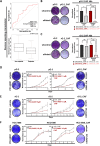HDAC8 suppresses the epithelial phenotype and promotes EMT in chemotherapy-treated basal-like breast cancer
- PMID: 35016723
- PMCID: PMC8753869
- DOI: 10.1186/s13148-022-01228-4
HDAC8 suppresses the epithelial phenotype and promotes EMT in chemotherapy-treated basal-like breast cancer
Abstract
Background: Basal-like breast cancer (BLBC) is one of the most aggressive malignant diseases in women with an increased metastatic behavior and poor prognosis compared to other molecular subtypes of breast cancer. Resistance to chemotherapy is the main cause of treatment failure in BLBC. Therefore, novel therapeutic strategies counteracting the gain of aggressiveness underlying therapy resistance are urgently needed. The epithelial-to-mesenchymal transition (EMT) has been established as one central process stimulating cancer cell migratory capacity but also acquisition of chemotherapy-resistant properties. In this study, we aimed to uncover epigenetic factors involved in the EMT-transcriptional program occurring in BLBC cells surviving conventional chemotherapy.
Results: Using whole transcriptome data from a murine mammary carcinoma cell line (pG-2), we identified upregulation of Hdac4, 7 and 8 in tumor cells surviving conventional chemotherapy. Subsequent analyses of human BLBC patient datasets and cell lines established HDAC8 as the most promising factor sustaining tumor cell viability. ChIP-sequencing data analysis identified a pronounced loss of H3K27ac at regulatory regions of master transcription factors (TFs) of epithelial phenotype like Gata3, Elf5, Rora and Grhl2 upon chemotherapy. Interestingly, impairment of HDAC8 activity reverted epithelial-TFs levels. Furthermore, loss of HDAC8 activity sensitized tumor cells to chemotherapeutic treatments, even at low doses.
Conclusion: The current study reveals a previously unknown transcriptional repressive function of HDAC8 exerted on a panel of transcription factors involved in the maintenance of epithelial cell phenotype, thereby supporting BLBC cell survival to conventional chemotherapy. Our data establish HDAC8 as an attractive therapeutically targetable epigenetic factor to increase the efficiency of chemotherapeutics.
Keywords: BLBC; Chemotherapy; EMT; Epigenetics; Epithelial transcription factors; H3K27ac; HDAC8; MET; TNBC.
© 2022. The Author(s).
Conflict of interest statement
The authors declare that they have no competing interests.
Figures





Similar articles
-
FOXF2 suppresses the FOXC2-mediated epithelial-mesenchymal transition and multidrug resistance of basal-like breast cancer.Cancer Lett. 2015 Oct 28;367(2):129-37. doi: 10.1016/j.canlet.2015.07.001. Epub 2015 Jul 22. Cancer Lett. 2015. PMID: 26210254
-
FOXF2 deficiency promotes epithelial-mesenchymal transition and metastasis of basal-like breast cancer.Breast Cancer Res. 2015 Feb 26;17(1):30. doi: 10.1186/s13058-015-0531-1. Breast Cancer Res. 2015. PMID: 25848863 Free PMC article.
-
Suberoylanilide hydroxamic acid (SAHA) promotes the epithelial mesenchymal transition of triple negative breast cancer cells via HDAC8/FOXA1 signals.Biol Chem. 2016 Jan;397(1):75-83. doi: 10.1515/hsz-2015-0215. Biol Chem. 2016. PMID: 26431101
-
The clinical significance of histone deacetylase-8 in human breast cancer.Pathol Res Pract. 2021 Apr;220:153396. doi: 10.1016/j.prp.2021.153396. Epub 2021 Mar 1. Pathol Res Pract. 2021. PMID: 33691240 Review.
-
Epigenetic Regulation of Inflammatory Cytokine-Induced Epithelial-To-Mesenchymal Cell Transition and Cancer Stem Cell Generation.Cells. 2019 Sep 25;8(10):1143. doi: 10.3390/cells8101143. Cells. 2019. PMID: 31557902 Free PMC article. Review.
Cited by
-
Emerging Role of Epigenetic Modifiers in Breast Cancer Pathogenesis and Therapeutic Response.Cancers (Basel). 2023 Aug 7;15(15):4005. doi: 10.3390/cancers15154005. Cancers (Basel). 2023. PMID: 37568822 Free PMC article. Review.
-
Epigenetic regulation and therapeutic targets in the tumor microenvironment.Mol Biomed. 2023 Jun 5;4(1):17. doi: 10.1186/s43556-023-00126-2. Mol Biomed. 2023. PMID: 37273004 Free PMC article. Review.
-
CK2B Induces CD8+ T-Cell Exhaustion through HDAC8-Mediated Epigenetic Reprogramming to Limit the Efficacy of Anti-PD-1 Therapy in Non-Small-Cell Lung Cancer.Adv Sci (Weinh). 2025 Apr;12(16):e2411053. doi: 10.1002/advs.202411053. Epub 2025 Feb 27. Adv Sci (Weinh). 2025. PMID: 40013761 Free PMC article.
-
ROBO3s: a novel ROBO3 short isoform promoting breast cancer aggressiveness.Cell Death Dis. 2022 Sep 3;13(9):762. doi: 10.1038/s41419-022-05197-7. Cell Death Dis. 2022. PMID: 36057630 Free PMC article.
-
Histone acetylation modulators in breast cancer.Breast Cancer Res. 2025 Mar 31;27(1):49. doi: 10.1186/s13058-025-02006-9. Breast Cancer Res. 2025. PMID: 40165290 Free PMC article. Review.
References
Publication types
MeSH terms
Substances
Grants and funding
LinkOut - more resources
Full Text Sources
Medical
Miscellaneous

